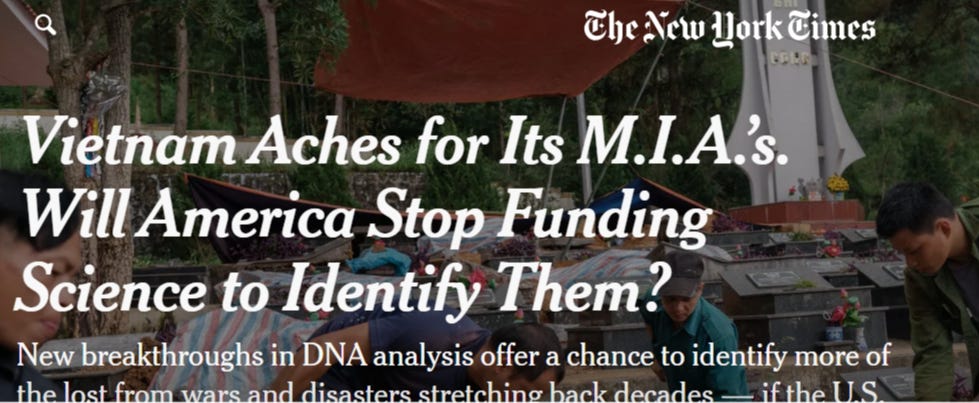You know, news articles like this are precisely why I chose Grumpy Old Vietnam Hand as my Substack handle when I started last August. Not because I’m nostalgic - and not just because I’m grumpy - but because I’ve spent decades watching even resident correspondents flatten Vietnam’s war-time history into tidy, guilt-soaked narratives. This latest piece, a classic case.
It’s not some blow-in stringer. No, this is the New York Times’ man on the ground. And yet here we are again: a few summary paragraphs about what supposedly happened during the war, a modern political hook (Trump kills USAID!), and a familiar framing - Vietnam as the eternal victim of American neglect.
Remember ProPublica’s screaming back in March about Trump halting an Agent Orange cleanup that was going to poison half of Ho Chi Minh City once the rains came? Well, it’s raining like hell now. And where’s your follow-up story, eh? Typical.
And of course, it’s always about America. Still. As if Vietnam were just a backdrop for U.S. drama - a place where things only matter when they intersect with American guilt or domestic politics. You’d think, after half a century, they’d realise they don’t own the place anymore.
The New York Times story is about Vietnam’s ongoing effort to identify its war dead using DNA - a deeply human, scientifically complex, and politically sensitive undertaking. But you wouldn’t know that from the way it’s framed.
Instead, the piece reads like a familiar morality play: the Vietnamese are grieving, the Americans were helping, and then Trump came along and ruined everything by cutting USAID funding. Cue the hand-wringing.
But here’s what the NYT doesn’t tell you:
- Vietnam launched this project in 2014, years before Trump entered the picture.
- The DNA lab opened in 2019, and the real scientific breakthrough - extracting usable DNA from degraded remains - happened without U.S. help.
-Vietnamese scientists, many of them women, have been leading this work quietly and competently for years.
-USAID’s role was supportive, not central - and certainly not the catalyst.
And let’s talk about that U.S. funding. The NYT makes it sound like America was bankrolling the whole operation. In reality? USAID contributed just $7.4 million over eight years - that’s less than a million bucks a year. For a project dealing with 1.2 million war dead and 300,000 still missing, it’s a rounding error. Chump change. But sure, let’s centre the story on Washington’s generosity.
And yes, I know USAID. I used to work for ’em — in South Vietnam, when it meant something even if there were too many of us and we thought we were running the place. These days, USAID cutoff stories are a dime a dozen around the world. But somehow, when it’s Vietnam, it still gets dressed up in moral panic and Cold War hangover.
Yet the Times gives us a narrative where Vietnamese agency is side-lined, and American involvement is the only thing that makes the story newsworthy. It’s not just misleading - it’s a disservice to the people actually doing the work.
This article is also typical of New York Times reportage out of today’s Vietnam - overwhelmingly America-centric. Whether it’s My Lai, Agent Orange or Trump’s tariffs (yes, not one but two stories this year), the narrative lens rarely shifts. Vietnam is cast as a stage for American guilt, American policy, American drama. The Vietnamese themselves? Often reduced to background characters in their own story. How about some real stories about Vietnam?
And I do get it - USAID cut-offs are generating a lot of public anger these days, especially among a certain class of readers who see them as symbolic of America’s retreat from global responsibility. And stories like this one are designed to tap right into that sentiment. So yes, I’m sticking my neck out here. But someone has to say it: this isn’t a story about American abandonment. It’s a story about Vietnamese persistence - and they missed it. And they can get along very well without you too, America.
And let’s not pretend Vietnamese MIAs aren’t like America’s. After ’75, Washington slapped an embargo, demanded its own missing, and never lifted a finger to help Vietnam find theirs. In fact, progress on U.S. MIAs was made the price of establishing diplomatic relations with Hanoi - and then kept moving the goalposts. But now, a few million in USAID money gets spun as moral leadership? That’s rich.
The Vietnamese launched this project in 2014 during the Obama years. Their lab opened in 2019. But the NYT only shows up when Trump cuts the chequebook? That’s not journalism - that’s narrative management.
And that’s what makes me a Grumpy Old Vietnam Hand.



